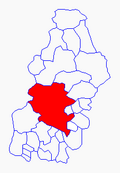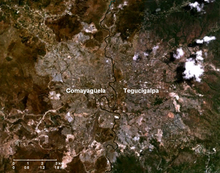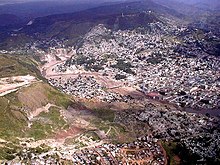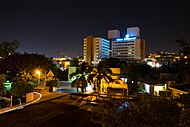
A | B | C | D | E | F | G | H | CH | I | J | K | L | M | N | O | P | Q | R | S | T | U | V | W | X | Y | Z | 0 | 1 | 2 | 3 | 4 | 5 | 6 | 7 | 8 | 9
Tegucigalpa | |
|---|---|
| Tegucigalpa, Municipio del Distrito Central | |
Skyline with the north of the city; Tegucigalpa at night; Honduras flag in the Suyapa Plaza; View of the city from the mountains | |
| Nickname(s): | |
 Location of the Central District within the Department of Francisco Morazán | |
| Coordinates: 14°06′21″N 87°12′17″W / 14.10583°N 87.20472°W | |
| Country | Honduras |
| Department | Francisco Morazán |
| Municipality | Central District |
| Founded | 29 September 1578 |
| Capital | 30 October 1880 |
| Merged as Central District | 30 January 1937 |
| Government | |
| • Type | Mayor-Council |
| • Body | Municipal Corporation |
| • Mayor | Jorge Aldana (LIBRE) |
| • Vice Mayor | Cárlenton Dávila (PSH) |
| • Aldermen | |
| • Municipal Secretary | Cosette Lopez Osorio |
| Area | |
| • Capital city | 1,502 km2 (580 sq mi) |
| • Urban | 201.5 km2 (77.8 sq mi) |
| Elevation | 990 m (3,250 ft) |
| Population (2023 projection)[5] | |
| • Capital city | 1,326,460 |
| • Density | 880/km2 (2,300/sq mi) |
| • Urban | 1,199,136 |
| Demonym(s) | Spanish: tegucigalpense, comayagüelense, capitalino(a) |
| GDP (PPP, constant 2015 values) | |
| • Year | 2023 |
| • Total | $10.5 billion[6] |
| • Per capita | $6,700 |
| Time zone | UTC−6 (Central America) |
| Postal code | |
| Area code | (country) +504 (city) 2[8] |
| Annual budget (2008) | 1.555 billion lempiras (US$82,190,000) |
| Website | Government of Tegucigalpa |
Tegucigalpa (UK: /tɛˌɡuːsɪˈɡælpə/[9] US: /təˌ-/[10][11] Spanish: [teɣusiˈɣalpa])—formally Tegucigalpa, Municipality of the Central District (Spanish: Tegucigalpa, Municipio del Distrito Central or Tegucigalpa, M.D.C.[12]), and colloquially referred to as Tegus or Teguz[13]—is the capital and largest city of Honduras along with its sister city, Comayagüela.[14]
Claimed on 29 September 1578 by the Spaniards,[15] Tegucigalpa became the Honduran capital on 30 October 1880, under President Marco Aurelio Soto, when he moved the seat of government from Comayagua,[16] which had been the Honduran capital since its independence in 1841. The 1936 constitution established Tegucigalpa and Comayagua as a Central District,[17] and the current 1982 Honduran Constitution continues to define the sister cities as a Central District that serves as the permanent national capital.[18][19]
Tegucigalpa is located in the southern-central highland region known as the department of Francisco Morazán of which it is also the departmental capital.[20] It is situated in a valley, surrounded by mountains. Tegucigalpa and Comayagua, being sister cities, are physically separated by the Choluteca River.[21] The Central District is the largest of the 28 municipalities in the Francisco Morazán department.[22]
Tegucigalpa is Honduras' largest and most populous city as well as the nation's political and administrative center. Tegucigalpa is host to 25 foreign embassies and 16 consulates.[23][24] It is the home base of several state-owned entities such as ENEE and Hondutel, the national energy and telecommunications companies, respectively.[25] The city is also home to the country's most important public university, the National Autonomous University of Honduras,[26] as well as the national soccer team.[27] The city is served by two international airports, Comayagua and Toncontín.[28][29][30]
The Central District Mayor's Office (Alcaldia Municipal del Distrito Central) is the city's governing body,[31] headed by a mayor[32] and 10 aldermen forming the Municipal Corporation (Corporación Municipal).[33] Being the department's seat as well, the governor's office of Francisco Morazán is also located in the capital. In 2008, the city operated on an approved budget of 1.555 billion lempiras (US$82,189,029).[34] In 2009, the city government reported a revenue of 1.955 billion lempiras (US$103,512,220), more than any other capital city in Central America except Panama City.[citation needed]
Tegucigalpa's infrastructure has not kept up with its population growth.[35] Deficient urban planning,[36] densely condensed urbanization, and poverty[37] are ongoing problems.[38] Heavily congested roadways, where road infrastructure is unable to efficiently handle over 400,000 vehicles, create havoc on a daily basis.[39] Both national and local governments have taken steps to improve and expand infrastructure as well as to reduce poverty in the city.[40][41]
Etymology
Most sources indicate the origin and meaning of the word Tegucigalpa is derived from the Nahuatl language.[42] The most widely accepted version suggests that it comes from the Nahuatl word Taguz-galpa, which means "hills of silver", but this interpretation is uncertain since the natives who occupied the region at the time were unaware of the existence of mineral deposits in the area.
Another source suggests that Tegucigalpa derives from another language in which it means painted rocks, as explained by Leticia Oyuela in her book Minimum History of Tegucigalpa.[43] Other theories indicate it may derive from the term Togogalpa, which refers to tototi (meaning a small green parrot, in Nahuatl) and Toncontín, a small town near Tegucigalpa (toncotín was a Mexican dance of Nahuatl origin).[44][45]
In Mexico, it is believed the word Tegucigalpa is from the Nahuatl word Tecuztlicallipan, meaning "place of residence of the noble" or Tecuhtzincalpan, meaning "place on the home of the beloved master".[46]
Honduran philologist Alberto de Jesús Membreño wrote in his book Indigenous Toponymies of Central America that he thinks Tegucigalpa is a Nahuatl word meaning "in the homes of the sharp stones" and rules out the traditional meaning "hills of silver" arguing that Taguzgalpa was the name of the ancient eastern zone of Honduras.[47]
History



Tegucigalpa was founded by Spanish settlers as Real de Minas de San Miguel de Tegucigalpa on September 29, 1578 on the site of an existing native settlement of the Lenca and Tolupans.[48] The first mayor of Tegucigalpa was Juan de la Cueva, who took office in 1579.[49] The Dolores Church (1735), the San Miguel Cathedral (1765), the Casa de la Moneda (1780), and the Immaculate Conception Church (1788) were some of the first important buildings constructed.[50]
Almost 200 years later, on June 10 1762, this mining town became Real Villa de San Miguel de Tegucigalpa y Heredia under the rule of Alonso Fernández de Heredia, then-acting governor of Honduras. The late 18th and early 19th centuries saw disruption in Tegucigalpa's local government, from being extinguished in 1788 to becoming part of Comayagua in 1791 to returning to self-city governance in 1817.[51]
In 1817, then-Mayor Narciso Mallol started the construction of the first bridge, a ten-arch masonry, connecting both sides of the Choluteca River. Upon completion four years later, it linked Tegucigalpa with her neighbor city of Comayagua.[52] In 1821, Tegucigalpa legally became a city.[53] In 1824, the first Congress of the Republic of Honduras declared Tegucigalpa and Comayagua, then the two most important cities in the country, to alternate as capital of the country.[54]
After October 1838, following Honduras' independence as a single republic, the capital continued to switch back and forth between Tegucigalpa and Comayagua until October 30, 1880, when Tegucigalpa was declared the permanent capital of Honduras by then-president Marco Aurelio Soto.[16] A popular myth claims that the society of Comayagua, the long-time colonial capital of Honduras, publicly disliked the wife of President Soto, who took revenge by moving the capital to Tegucigalpa.[55] A more likely theory is that the change took place because President Soto was an important partner of the Rosario Mining Company, an American silver mining company, whose operations were based in San Juancito, close to Tegucigalpa, and he needed to be close to his personal interests.[56]
By 1898, it was decided that both Tegucigalpa and Comayagua, being neighbor cities on the banks of the Choluteca River, would form the capital, but with separate names and separate local governments.[57] During this period, both cities had a population of about 40,000 people.

Between the 1930s and 1960s, Tegucigalpa continued to grow reaching a population of over 250,000 people, giving way to what would become one of the biggest neighborhoods in the city, the Colonia Kennedy; the nation's autonomous university, the UNAH; and the construction of the Honduras Maya Hotel.[58] It still remained relatively small and provincial until the 1970s, when migration from the rural areas began in earnest. During the 1980s, several avenues, traffic overpasses, and large buildings were erected, a relative novelty to a city characterized until then by two-story buildings.[59] However, lacking the enforcement of city planning and zoning laws, it led to highly disorganized urbanization. This lack of proper urbanization as the population has grown is evident on the surrounding slopes of the several hills in the city where some of the city's most impoverished neighborhoods have prevailed.[60]
On 30 October 1998, Hurricane Mitch devastated the capital, along with the rest of Honduras.[61] For five days, Mitch pounded the country creating devastating landslides and floods, causing the death of thousands as well as heavy deforestation and the destruction of thousands of homes.[62] A portion of Comayagua was destroyed along with several neighborhoods on both sides of the Honduran capital. After the hurricane, infrastructure in Tegucigalpa was severely damaged. Even 12 years later, remnants of Hurricane Mitch were still visible, especially along the banks of the Choluteca River.[63][64]
Today, Tegucigalpa continues to sprawl far beyond its former colonial core: towards the east, south and west, creating a large but disorganized metropolis. In an effort to modernize the capital, increase its infrastructure and improve the quality of life of its inhabitants, the administration has passed several ordinances and projects to turn the city around within the upcoming years.[65]
Geography


Tegucigalpa is located on a chain of mountains with elevations of 975 metres (3,199 ft) at its lowest points and 1,463 metres (4,800 ft) at its highest suburban areas. Like most of the interior highlands of Honduras, the majority of Tegucigalpa's current area was occupied by open woodland. The area surrounding the city continues to be open woodland supporting pine forest interspersed with some oak, scrub, and grassy clearings as well as needle leaf evergreen and broadleaf deciduous forest.
The metropolitan area of both Tegucigalpa and Comayagua covers a total area of 201 square kilometers (77.6 sq mi) while the entire Municipality of the Central District covers a total area of 1,396 square kilometers (539.1 sq mi).[4] Geological faults that are a threat to the neighborhoods on and below the hill have been identified in the District's high regions surrounding the capital.[66]
The Choluteca River, which crosses the city from south to north, physically separates Tegucigalpa and Comayagua.[67] El Picacho Hill, a rugged mountain of moderate height, rises above the downtown area; several neighborhoods, both upscale residential and lower income, are located on its slopes. The city consists of gentle hills, and the ring of mountains surrounding the city tends to trap pollution.[68] During the dry season, a dense cloud of smog lingers in the basin until the first rains fall.

Tucked into a valley and bisected by a river, Tegucigalpa is prone to flooding during the rainy season, as experienced to the fullest during Hurricane Mitch and to a lesser degree every year during the rainy season. Despite being several thousand feet above sea level, the city lacks an efficient flood control system, including canals and sewerage powerful enough to channel rainwater back into the river to flow down to the ocean. The river itself is a threat since it isn't deep enough below the streets, nor are there levees high enough to prevent it from breaking out.[69] There are more than 100 neighborhoods deemed zones of high risk, several of them ruled out as uninhabitable in their entirety.[60]
There is a reservoir, known as Embalse Los Laureles, west of the city providing 30 percent of the city's water supply as well as a water treatment plant south of the city about 7.3 kilometres (4.5 mi) from the airport; part of the Concepción Reservoir just 6 kilometres (3.7 mi) southwest of the water plant.[70]
The Central District shares borders with 13 other municipalities of Francisco Morazán:[22] (to the north) Cedros and Talanga; (south) Ojojona, Santa Ana, San Buenaventura and Maraita; (east) San Juan de Flores, Villa de San Francisco, Santa Lucía, Valle de Ángeles, San Antonio de Oriente, and Tatumbla; (and to the west) Lepaterique. It is also bordered on the west by two municipalities of the Comayagua Department, Villa de San Antonio[71] and Lamaní, with the latter exactly at the quadripoint where the Central District, Lepaterique, Villa de San Antonio and Lamaní all meet.
Climate

Tegucigalpa has a tropical savanna climate (Aw, according to the Köppen climate classification), milder due to the elevation and with two distinct seasons: the rainy season, and the dry season.[72] Like much of central Honduras, the city has a tropical climate, though tempered by the altitude—meaning less humid than the lower valleys and the coastal regions—with median temperatures averaging between 19 °C (66 °F) and 23 °C (73 °F) degrees.[73]
The months of December and January are coolest, with an average min/ low temperature of 14 °C (57 °F); whereas March and April—popularly associated with Holy Week's holidays—are hottest and temperatures can reach up to 40 °C (104 °F) degrees on the hottest day.[74] The dry season lasts from November through April and the rainy season from May through October.[75] There is an average of 107 rainy days in the year, June and September usually the wettest months.
The average sunshine hours per month during the year is 211.2 and the average rainy days per month is 8.9. The average sunshine hours during the dry season is 228 per month while 182.5 millimetres (7.19 in) is the average monthly precipitation during the wet season. The wettest months of the rainy season are May—June and September—October, averaging 16.2 rainy days during each of those periods.
| Climate data for Tegucigalpa (Tegucigalpa Airport) 1961–1990, extremes 1951–present | |||||||||||||
|---|---|---|---|---|---|---|---|---|---|---|---|---|---|
| Month | Jan | Feb | Mar | Apr | May | Jun | Jul | Aug | Sep | Oct | Nov | Dec | Year |
| Record high °C (°F) | 33.0 (91.4) |
34.5 (94.1) |
35.5 (95.9) |
36.6 (97.9) |
36.9 (98.4) |
34.5 (94.1) |
35.9 (96.6) |
36.9 (98.4) |
34.2 (93.6) |
34.8 (94.6) |
32.8 (91.0) |
31.4 (88.5) |
36.9 (98.4) |
| Mean daily maximum °C (°F) | 25.7 (78.3) |
27.4 (81.3) |
29.5 (85.1) |
30.2 (86.4) |
30.2 (86.4) |
28.6 (83.5) |
27.8 (82.0) |
28.5 (83.3) |
28.5 (83.3) |
27.3 (81.1) |
26.0 (78.8) |
25.4 (77.7) |
27.9 (82.2) |
| Daily mean °C (°F) | 19.5 (67.1) |
20.4 (68.7) |
22.1 (71.8) |
23.4 (74.1) |
23.6 (74.5) |
22.6 (72.7) |
22.1 (71.8) |
22.4 (72.3) |
22.2 (72.0) |
21.5 (70.7) |
20.4 (68.7) |
19.7 (67.5) |
21.7 (71.1) |
| Mean daily minimum °C (°F) | 14.3 (57.7) |
14.5 (58.1) |
15.5 (59.9) |
17.1 (62.8) |
18.2 (64.8) |
18.2 (64.8) |
18.0 (64.4) |
18.0 (64.4) |
17.9 (64.2) |
17.6 (63.7) |
16.3 (61.3) |
15.0 (59.0) |
16.7 (62.1) |
| Record low °C (°F) | 4.5 (40.1) |
7.2 (45.0) |
4.7 (40.5) |
8.9 (48.0) |
11.1 (52.0) |
12.4 (54.3) |
12.6 (54.7) |
12.2 (54.0) |
11.0 (51.8) |
10.0 (50.0) |
7.7 (45.9) |
6.8 (44.2) |
4.5 (40.1) |
| Average precipitation mm (inches) | 5.3 (0.21) |
4.7 (0.19) |
9.9 (0.39) |
42.9 (1.69) |
143.5 (5.65) |
158.7 (6.25) |
82.3 (3.24) |
88.5 (3.48) |
177.2 (6.98) |
108.9 (4.29) |
39.9 (1.57) |
9.9 (0.39) |
871.7 (34.32) |
| Average precipitation days (≥ 1.0 mm) | 1 | 1 | 1 | 2 | 9 | 12 | 9 | 9 | 13 | 10 | 4 | 2 | 73 |
| Average relative humidity (%) | 71 | 66 | 62 | 60 | 67 | 75 | 74 | 73 | 76 | 78 | 77 | 75 | 71 |
| Mean monthly sunshine hours | 220.8 | 229.4 | 268.5 | 242.8 | 216.3 | 171.7 | 192.5 | 204.8 | 183.4 | 200.4 | 199.2 | 212.2 | 2,542 |
| Source 1: NOAA[76] | |||||||||||||
| Source 2: Deutscher Wetterdienst (humidity, 1951–1993)[77] Meteo Climat (record highs and lows)[78] | |||||||||||||
Hurricane Mitch

Tegucigalpa, as with the rest of Honduras, experienced significant damage by Hurricane Mitch in late-October and early-November 1998, something of a magnitude Hondurans had not witnessed since Hurricane Fifi. Mitch destroyed part of the Comayagua section of the city, as well as other places along the banks of the Choluteca River. The storm remained over Honduran territory for five days, dumping heavy rainfall late in the rainy season. The ground was already saturated and could not absorb the heavy precipitation, while deforestation and debris left by the hurricane led to catastrophic flooding throughout widespread regions of the country, especially in Tegucigalpa.[79]
The heavy rain caused flash floods of Choluteca's tributaries, and the swollen river overflowed its banks, tearing down entire neighborhoods and bridges across the ravaged city. The rainfall also triggered massive landslides around El Berrinche Hill, close to the downtown area. These landslides destroyed most of the Soto neighborhood, and debris flowed into the river, forming a dam. The dam clogged the waters of the river and many of the low-lying areas of Comayagua were submerged; historic buildings located along Calle Real were either completely destroyed or so badly damaged that repair was futile.[80]
Cityscape

Situated in a valley and surrounded by mountain ranges, Tegucigalpa is hilly with several elevations and few flat areas. The city is also highly disorganized, particularly around its oldest districts.[81][82][83] It has seen a rapid growth in the last 30 years,[84] and only recently has the government passed some of the laws establishing city planning and zoning rules.[85] Surface roads can be narrow with the most important avenues carrying no more than two or three lanes running in each direction, adding to the problem of heavy traffic congestion. Several of the main boulevards have been equipped with interchanges, overpasses and underpasses, allowing for sections of controlled-access highways, but considering that even the city's beltway does not entirely circle the city, the roads are generally limited-access. Intense webs of electrical and telephone lines above the streets are a common sight in the capital, and in virtually all Honduran cities, since the implementation of underground utility lines has only been adopted in recent years.
Zdroj:https://en.wikipedia.org?pojem=Comayagüela
Text je dostupný za podmienok Creative Commons Attribution/Share-Alike License 3.0 Unported; prípadne za ďalších podmienok. Podrobnejšie informácie nájdete na stránke Podmienky použitia.
Antropológia
Aplikované vedy
Bibliometria
Dejiny vedy
Encyklopédie
Filozofia vedy
Forenzné vedy
Humanitné vedy
Knižničná veda
Kryogenika
Kryptológia
Kulturológia
Literárna veda
Medzidisciplinárne oblasti
Metódy kvantitatívnej analýzy
Metavedy
Metodika
Text je dostupný za podmienok Creative
Commons Attribution/Share-Alike License 3.0 Unported; prípadne za ďalších
podmienok.
Podrobnejšie informácie nájdete na stránke Podmienky
použitia.
www.astronomia.sk | www.biologia.sk | www.botanika.sk | www.dejiny.sk | www.economy.sk | www.elektrotechnika.sk | www.estetika.sk | www.farmakologia.sk | www.filozofia.sk | Fyzika | www.futurologia.sk | www.genetika.sk | www.chemia.sk | www.lingvistika.sk | www.politologia.sk | www.psychologia.sk | www.sexuologia.sk | www.sociologia.sk | www.veda.sk I www.zoologia.sk










